╔
Introduction
Hudson River Park is a waterfront park on the North River (Hudson River) that extends from 59th Street south to Battery Park in the New York City borough of Manhattan. The park, a component of the Manhattan Waterfront Greenway, stretches 4.5 miles (7.2 km) and comprises 550 acres (220 ha), making it the second-largest park in Manhattan after the 843-acre (341 ha) Central Park. The park was established in 1998 and was built in several stages in conjunction with the construction of the surface-level West Side Highway. Additional phases were completed between the 2000s and the 2020s. Hudson River Park connects many other recreational sites and landmarks. It runs through the Manhattan neighbourhoods of Lower Manhattan (including Battery Park City, World Trade Center, and Tribeca), Greenwich Village (including the West Village and Meatpacking District), Chelsea, and Midtown West (which includes Hudson Yards and Hell’s Kitchen/Clinton). The park connects also two other waterfront parks: Riverside Park to the north and The Battery to the south.
Map of the Hudson River Park. (Source: https://hudsonriverpark.org).

Bicycle and pedestrian paths, spanning the park north to south, open up the waterfront for recreational use. The park includes tennis and soccer fields, batting cages, children’s playground, dog run, and many other features. The parkland also incorporates several rebuilt North River piers along its length, formerly used for shipping.
The first complete section of the park started construction in 1998 and opened in 2003 in Greenwich Village.
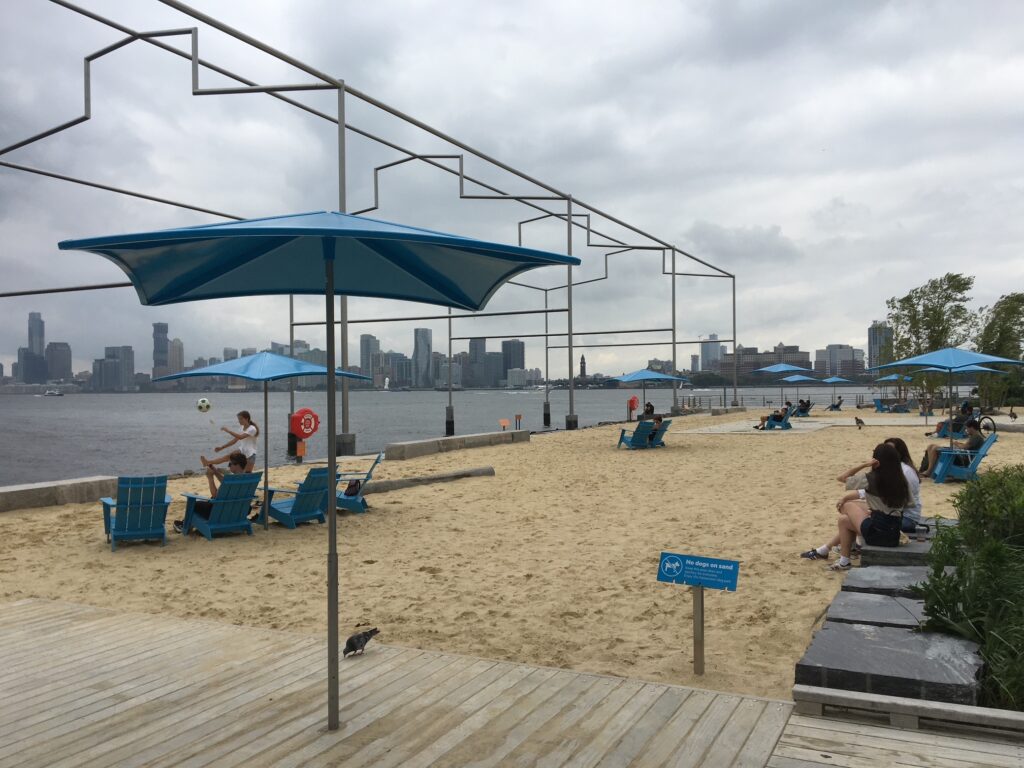
The Gansevoort Peninsula Sand Bluff on the Hudson River pier. (© Marta Moretti).
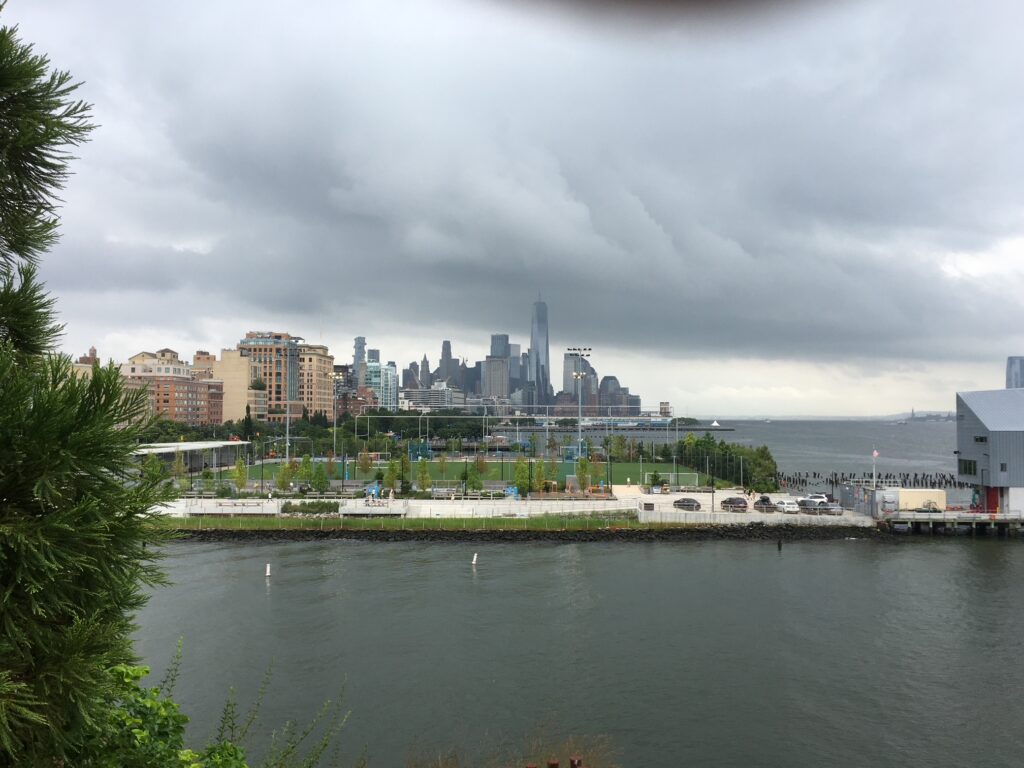
Sport infrastructures on Gansevoort Peninsula. (© Marta Moretti).
Little Island at Pier 54
The most recent step of this regeneration process is Little Island: a new, free public park within the larger Hudson River Park, opened to the public on May 21, 2021, providing New Yorkers and visitors from around the world with a unique green space unlike any other in New York City. Planned in partnership with the Hudson River Park Trust, Little Island was funded primarily through Barry Diller and the Diller-Von Furstenberg Family Foundation through an extraordinary philanthropic gift to the Hudson River Park.
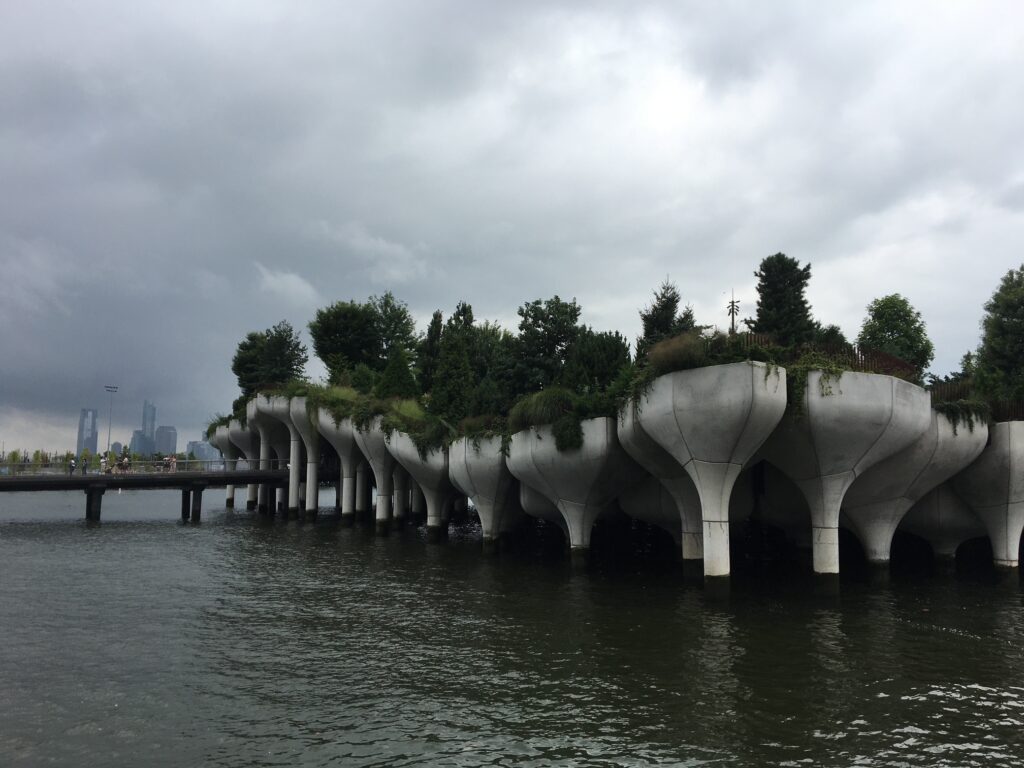
View of Little Island from Pier 57. (© Marta Moretti).
Little Island is a new public park, where New Yorkers and visitors can experience nature and art in a unique urban oasis on the Hudson River. Rising from the remnants of Pier 54, Little Island sits on a site that has played a pivotal role in the story of the Hudson River and its surrounding communities. Every visit to Little Island is a reminder of the dynamic evolution of New York City’s waterfront.
The land of Hudson River Park was once home to the Lenape tribe during the early colonization of America and it was used as a seasonal encampment for hunting and fishing, in addition to conducting trade along the River.
In 1915, the RMS Lusitania departed from Pier 54, only to be sunk by German U-boats off the coast of Ireland five days later as a casualty of World War I. The steel archway at the foot of Little Island’s South Bridge entrance remains from the Cunard-White Star building.
The pier eventually fell into disuse until the 1970s to the early 80s, when Pier 54–along with other piers south of Chelsea–became a safe haven for New York City’s growing LGBTQ community. Here, they could openly socialize without fear of harassment and discrimination. In 1986, Pier 54 became home to the annual Dance on the Pier event. For over 25 years, the event took place at the pier as part of the Pride festivities. Pier 54 eventually became part of the newly formed Hudson River Park in 1998, where it also served as a venue for summer events and concert series.
In 2012, Hurricane Sandy hit New York City’s coastline, heavily damaging several piers along the Hudson, including Pier 54. In 2013, Barry Diller of the Diller-von Furstenberg Family Foundation, in partnership with Hudson River Park Trust leadership, embarked on the unique opportunity to envision a solution for the repair and reactivation of Pier 54. Diller chose to reimagine an entirely new type of public space for New York, one that would create an immersive experience with nature and art.
The park and recreational areas at Little Island. (© Marta Moretti).
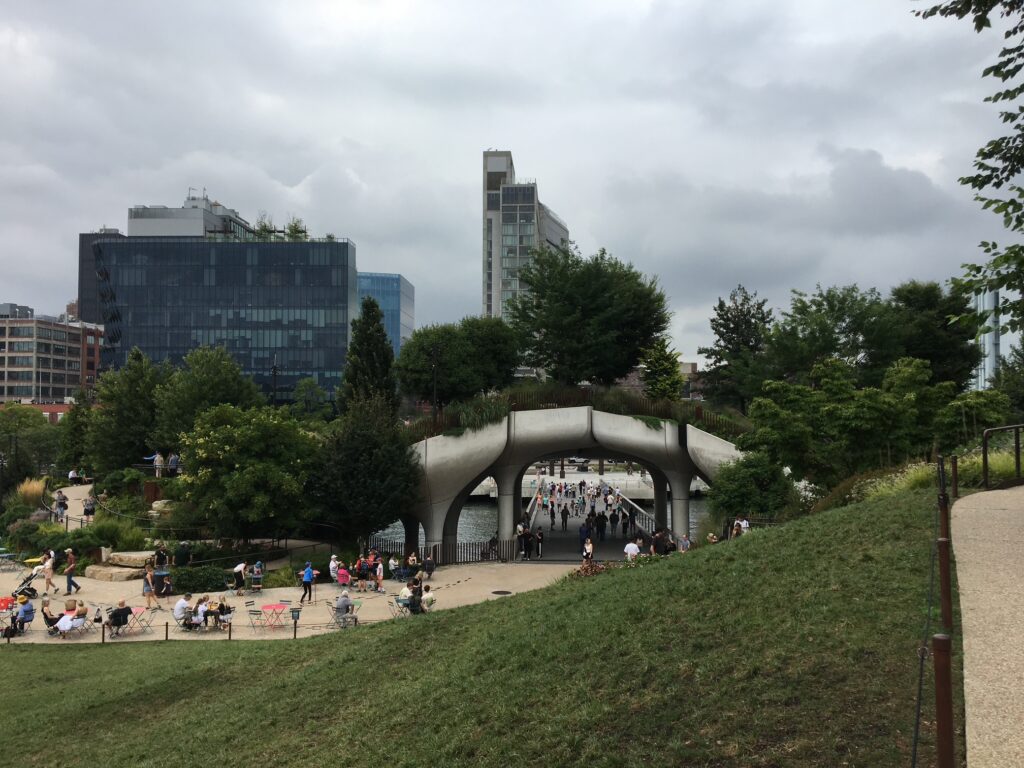
Little Island opened on May 21, 2021 as an oasis for New Yorkers, with more than two acres of magnificent landscape, distinctive architecture, dazzling views and an abundance of free education programs and performances. After Covid-19 pandemic, visitors embraced the essential need for a connection to nature, art and community and the island hosted more than 1M visitors in the inaugural year. Little Island continues to benefit from the generosity and commitment of the Diller-von Furstenberg Family Foundation. Since Little Island’s 2021 opening, 1,600 artists have helped to bring the park to life with their talents and creativity, performing all throughout our stages and delighting visitors at every turn.
An Evening with Seth Meyers and Friends at Little Island on 8/3/22. (© Lia Chang).
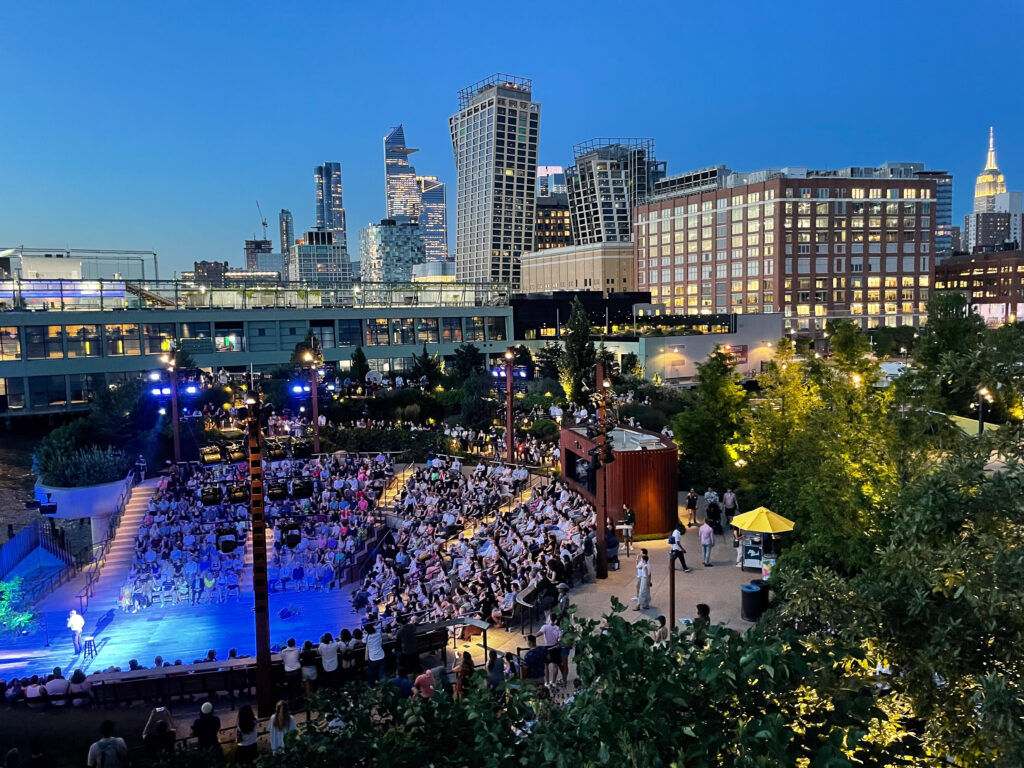
The Amphitheater at Little Island. (© Michael Grimm).
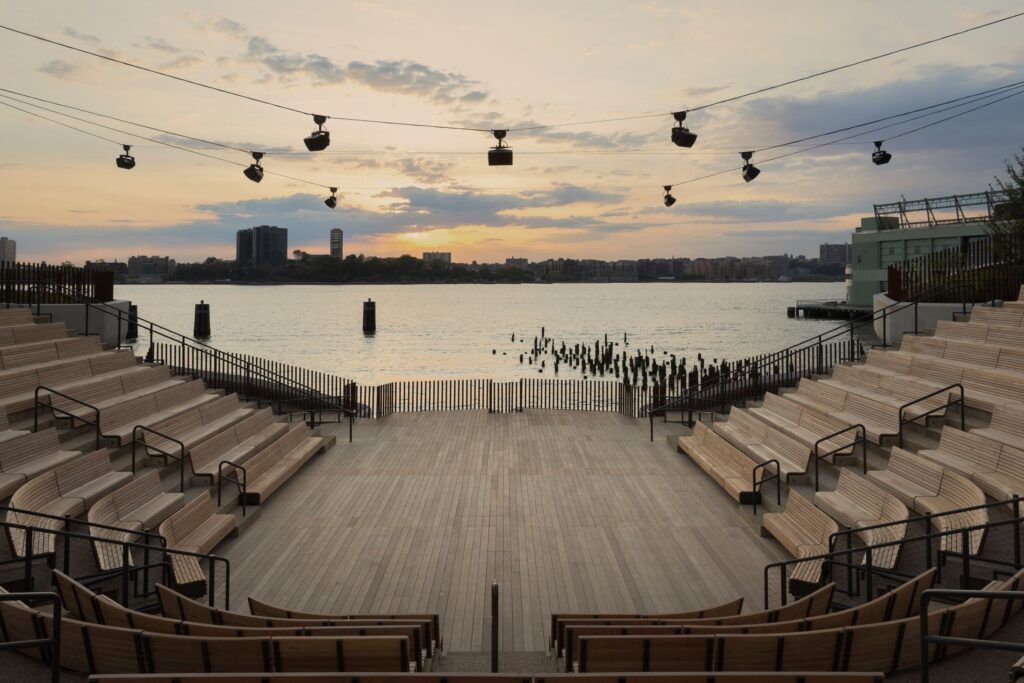
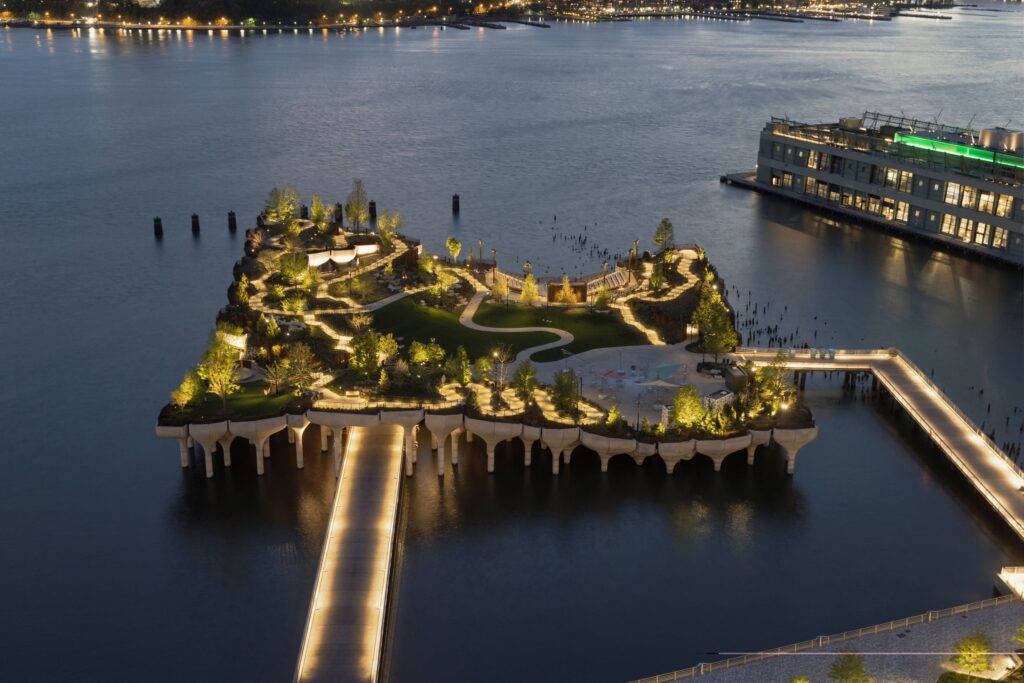
Aerial view of Little Island from the Standard. (© Michael Grimm).
Innovative Use for Pier 57
Nearby to Little Island, in Hudson River Park, is Pier 57: a culinary, recreational, and educational destination that celebrates the vitality of New York City and its diverse local community.
It was originally built in 1907 as a shipping and storage terminal and reconstructed by the NYC Department of Marine and Aviation in 1952. Designed by Emil H. Praeger, Pier 57 is considered an engineering marvel due to its innovative use of three hollow concrete caissons to support the main structure, rather than traditional pylons. It reopened in 1954 as the terminal for the Grace Line. Pier 57 is listed on the National Register of Historic Places and is a significant part of New York City’s history.
View of Pier 57. (© Marta Moretti).
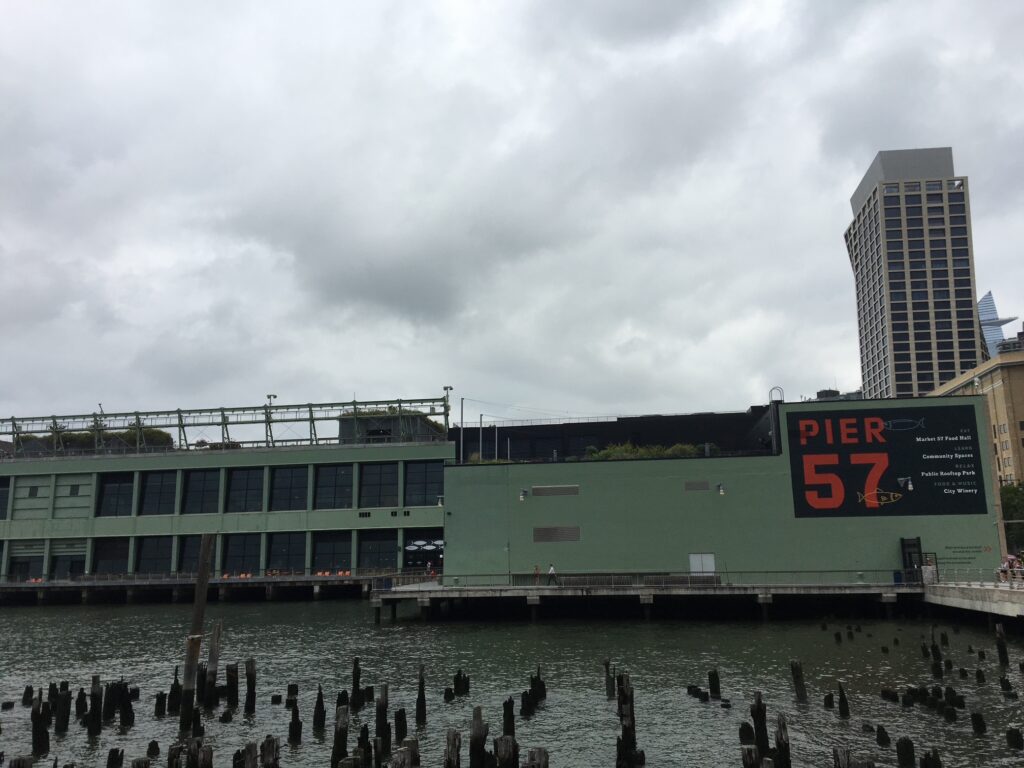
Pier 57 reopens April 1, 2023, as a vibrant community destination and partnership between Hudson River Park Trust, Google, RXR Realty, Youngwoo & Associates, and Jamestown. The new Pier 57 honours the original design and looks to the future through technologically advanced and enriching opportunities for the local community.
Whitney Museum of American Art
In this area along the Hudson River, a prominent and connecting role is played by the relocation of the Whitney Museum of American Art from its historic and iconic home in the Breuer Building, on Madison Avenue, to the new building in the Meatpacking District at 99 Gansevoort Street. Situated between the High Line and the Hudson River, the Whitney’s building offers the most expansive display ever of its unsurpassed collection of modern and contemporary American art.
Whitney Museum of American Art. (© Photograph by Max Touhey – Press Assets).
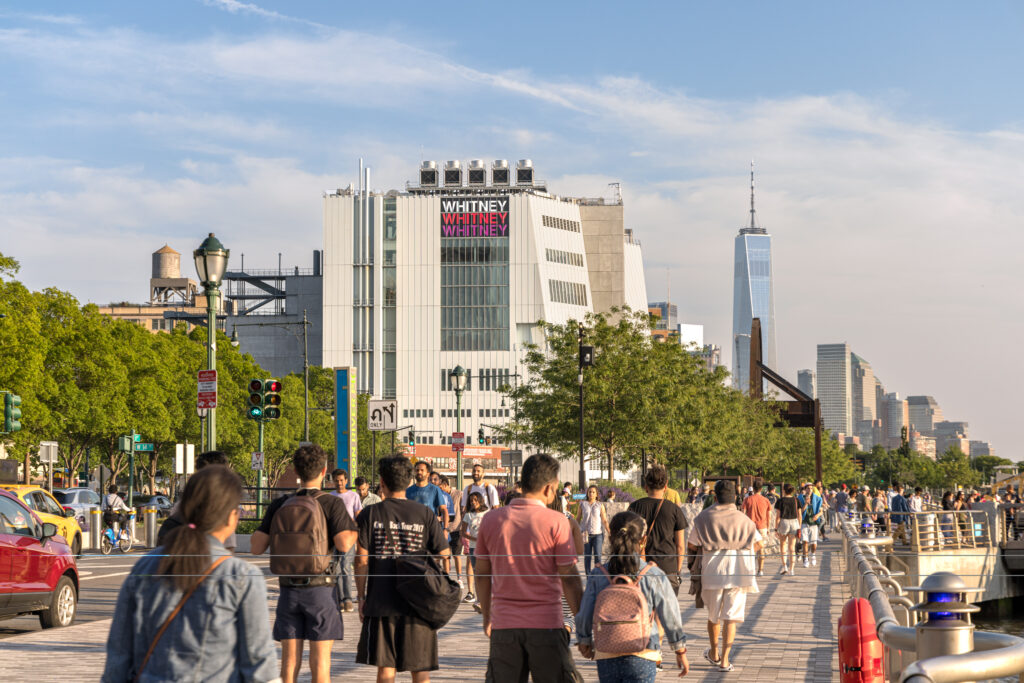
The new building, opened in 2015, engages the Whitney directly with the bustling community of artists, galleries, educators, entrepreneurs, and residents of the Meatpacking District, Chelsea, and Greenwich Village, where the Museum was founded by Gertrude Vanderbilt Whitney in 1930.
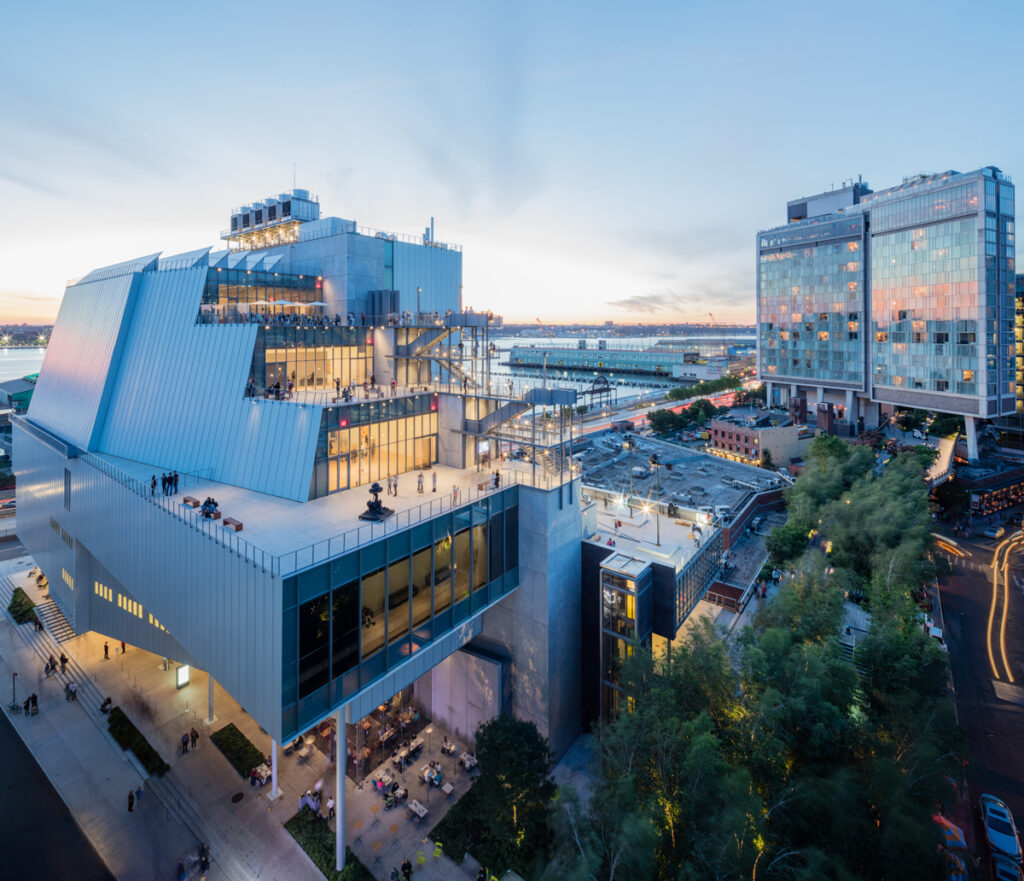
View of the Whitney Museum from the southeast. (© Photograph by Ben Gancsos – Press Assets).
Designed by architect Renzo Piano, the Whitney’s building includes approximately 50,000 square feet of indoor galleries and 13,000 square feet of outdoor exhibition space and terraces facing the High Line. An expansive gallery for special exhibitions is approximately 18,000 square feet in area, making it the largest column-free museum gallery in New York City. Additional exhibition space includes a lobby gallery – accessible free of charge -, two floors for the permanent collection, and a special exhibitions gallery on the top floor.
Renzo Piano’s design takes a strong and strikingly asymmetrical form—one that responds to the industrial character of the neighbouring loft buildings and overhead railway while asserting a contemporary, sculptural presence. The upper stories of the building overlook the Hudson River on its west, and step back gracefully from the elevated High Line Park to its east.
Piano remarked in 2011, “The design for the new museum emerges equally from a close study of the Whitney’s needs and from a response to this remarkable site. We wanted to draw on its vitality and at the same time enhance its rich character. The first big gesture, then, is the cantilevered entrance, which transforms the area outside the building into a large, sheltered public space. At this gathering place beneath the High Line, visitors will see through the building entrance and the large windows on the west side to the Hudson River beyond. Here, all at once, you have the water, the park, the powerful industrial structures and the exciting mix of people, brought together and focused by this new building and the experience of art”.
The building also includes an education center offering state-of-the-art classrooms; a multi-use black box theater for film, video, and performance with an adjacent outdoor gallery; a 170-seat theater with stunning views of the Hudson River; and a Works on Paper Study Center, Conservation Lab, and Library Reading Room.
Pier 59 in Chelsea
Much older in terms of regeneration but worthy to be mentioned in terms of uses, is Pier 59. Top destination for famed photographers, filmmakers, designers, brands, advertising and production companies worldwide, Pier59 Studios is a premiere 110,000-square-foot multimedia studio and live event space in New York City. Originally it was the site where millions of tons of cargo were unloaded, a large warehouse for salt and trucks for the city of New York, and it was the first stop for survivors on the Cunard Lines’ Carpathia before they docked a few blocks south at Pier54 to meet their loved ones. Pier 59 has been transformed from an abandoned place until the early 1990s into the largest studio in the Northeast of the United States, dedicated to photography, first digital and now also virtual. Today it is a place where technology and virtual reality allow you to recreate any place on the planet, ideal for shooting films or glamorous events. In 1995, Federico Pignatelli founded Pier59 Studios with the intent to repurpose it into the world’s leading studio complex in Manhattan’s fashionable Chelsea district. Its disruptive technology combines real-time CGI, LED displays, 3D camera tracking with live-action elements, allowing filmmakers to visualize final visual effects while filming. This revolutionary approach provides greater control, creative flexibility, and significant cost savings effectively redefining the content capture process.
HEAD IMAGE | The High Line in NYC. (© Marta Moretti).